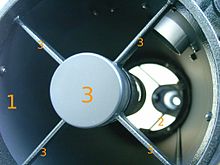https://en.wikipedia.org/wiki/Diffraction_spike
Support vanes

In the vast majority of reflecting telescope designs, the secondary mirror has to be positioned at the central axis of the telescope and so has to be held by struts within the telescope tube. No matter how fine these support rods are they diffract the incoming light from a subject star and this appears as diffraction spikes which are the Fourier transform of the support struts. The spikes represent a loss of light that could have been used to image the star.[3][4]
Although diffraction spikes can obscure parts of a photograph and are undesired in professional contexts, some amateur astronomers like the visual effect they give to bright stars – the "Star of Bethlehem" appearance – and even modify their refractors to exhibit the same effect,[5] or to assist with focusing when using a CCD.[6]
A small number of reflecting telescopes designs avoid diffraction spikes by placing the secondary mirror off-axis. Early off-axis designs such as the Herschelian and the Schiefspieglertelescopes have serious limitations such as astigmatism and long focal ratios, which make them useless for research. The brachymedial design by Ludwig Schupmann, which uses a combination of mirrors and lenses, is able to correct chromatic aberration perfectly over a small area and designs based on the Schupmann brachymedial are currently used for research of double stars.
There are also a small number of off-axis unobstructed all-reflecting anastigmats which give optically perfect images.
Refracting telescopes and their photographic images do not have the same problem as their lenses are not supported with spider vanes.
Non-circular aperture

Iris diaphragms with moving blades are used in most modern camera lenses to restrict the light received by the film or sensor. While manufacturers attempt to make the aperture circular for a pleasing bokeh, when stopped down to high f-numbers (small apertures), its shape tends towards a polygon with the same number of sides as blades. Diffraction spreads out light waves passing through the aperture perpendicular to the roughly-straight edge, each edge yielding two spikes 180° apart.[7] As the blades are uniformly distributed around the circle, on a diaphragm with an even number of blades, the diffraction spikes from blades on opposite sides overlap. Consequently, a diaphragm with n blades yields n spikes if n is even, and 2n spikes if n is odd.[8]
Segmented mirrors
Images from telescopes with segmented mirrors also exhibit diffraction spikes due to diffraction from the mirrors' edges. As before, two spikes are perpendicular to each edge orientation, resulting in six spikes (plus two fainter ones due to the spider supporting the secondary mirror) in photographs taken by the James Webb Space Telescope.[9]
"Knife edge"
The knife-edge effect or knife-edge diffraction is a truncation of a portion of the incident radiation that strikes a sharp well-defined obstacle, such as a mountain range or the wall of a building. The knife-edge effect is explained by the Huygens–Fresnel principle, which states that a well-defined obstruction to an electromagnetic wave acts as a secondary source, and creates a new wavefront. This new wavefront propagates into the geometric shadow area of the obstacle.
Knife-edge diffraction is an outgrowth of the "half-plane problem", originally solved by Arnold Sommerfeld using a plane wave spectrum formulation. A generalization of the half-plane problem is the "wedge problem", solvable as a boundary value problem in cylindrical coordinates. The solution in cylindrical coordinates was then extended to the optical regime by Joseph B. Keller, who introduced the notion of diffraction coefficients through his geometrical theory of diffraction (GTD). Pathak and Kouyoumjian extended the (singular) Keller coefficients via the uniform theory of diffraction (UTD).





